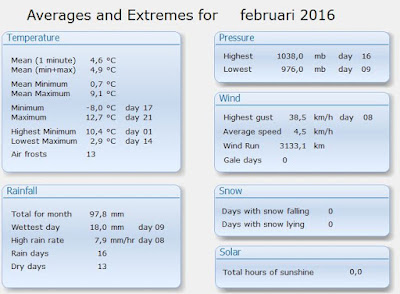The weather today was very unpredictable... rain and sunshine and thus high chance to observe rainbows. Around 5pm we could observe a double rainbow which was very bright and also I could see the dark band, Alexander's band.
Pascal Hilkens Astro Home Page
Monday, March 28, 2016
Update Usefull Links
Interesting to find more information on the Web? All software and websites I'm using I captured and updated recently on my existing webpage Usefull Links. Have fun!
Use of RegiStax6 Jupiter
In stead of using Autostakkert! I did use RegiStax6 to stack my .avi movies from Jupiter. The movies were taken using the ASI224MC camera on my dobson Orion XT12" last friday, March 25th.
The picture below is the result of 94 frames stacked and the imaged was saved under tiff and edited further using CS4. The final result is saved under jpg format.
Besides the four galilean moons - Io, Europa, Callisto and Ganymede you can alse recognize the "clouds" on Jupiter's "surface". The equatorial zone in the middle and north and south of this the temperate belts and tropical zones.
The picture below is the result of 94 frames stacked and the imaged was saved under tiff and edited further using CS4. The final result is saved under jpg format.
Besides the four galilean moons - Io, Europa, Callisto and Ganymede you can alse recognize the "clouds" on Jupiter's "surface". The equatorial zone in the middle and north and south of this the temperate belts and tropical zones.
The moon on Jan 17th, 2016
As I was looking how to optimize the stacking of frames from .AVI movies I retried the free software RegiStax6. Last time the use was too difficult for me but today i found some more time to practice.
The result below is a shot from the moon on Jan 17th, 2016 taken with camere ASI224MC on Dobson Orion XT12. The result was finished using CS4.
The result below is a shot from the moon on Jan 17th, 2016 taken with camere ASI224MC on Dobson Orion XT12. The result was finished using CS4.
 |
| After stacking with RegiStax 6 |
 |
| After stacking with RegiStax6 and editing using CS4 |
Jupiter with all four moons
On March 25th, I took some movie shots using the ASI224MC camera set on my dobson Orion XT12". The movies .avi format were stacked using autostakkert. See results this blog yesterday. Today I used the free software RegiStax 6 to stack the frames. The picture .tiff was edited using CS4.
The result is show below with Jupiter and his big 4 moons.
The result is show below with Jupiter and his big 4 moons.
Saturday, March 26, 2016
Alfa ORI - Betelgeuze
Orion Nebula M42 using ASI224MC
Refining my skills in using the ASI224MC camera. This time observation was done using my dobson Orion XT12" with direct use of the ZWO camera. Sharp Cap 2.8 was used to capture movies from ASI224MC camera. Afterwards frames are stacked using Autostakkert! and pictures are modified and edited with CS4.
Results show good colors and details. Remember this is all without guiding telescoop :)
Jupiter ASI224MC
Clear sky on March 25th and time to observe Jupiter. Using my Dobson Orion XT12" with ZWO Camera ASI224MC result in tens of AVI movies. Those are stacked using Autostackert! 2.5.1.18 and pictures are modified using CS4.
Pictures shows aswell three Jupiter moon Europa, Io and Callisto. Different banners are clearly visible on Jupiter's "surface".
Pictures shows aswell three Jupiter moon Europa, Io and Callisto. Different banners are clearly visible on Jupiter's "surface".
Sunday, March 20, 2016
Sunday, March 6, 2016
Starparty Langdorp March12th
On March12th, 2016, more then 25 locations in Belgium will be hosting a starparty. This national event is organised by VVS. In my region Langdorp (Aarschot) will be the one to get into contact as from 19h00.
See also Star Party Langdorp - Aarschot
See also Star Party Langdorp - Aarschot
Saturday, March 5, 2016
May 9th Transit of Mercury
On May 9th the planet Mercury will transit the sun. The last time we could observe this was in 2006 but this was not visible in Belgium. From Earth only Venus and Mercury can transit the sun as they are closer to the sun then Earth. These transits are rare and with Mercury this only happens about 13 times per 100 year.
For Belgium and the rest of Western Europe the transit is seen from begin (ingress) till end (egress). Timing is set below - be aware this is UTC which means for the region Time=UTC+2h and these are depending of the location of the observer - changes up to a couple of minutes.
For Belgium and the rest of Western Europe the transit is seen from begin (ingress) till end (egress). Timing is set below - be aware this is UTC which means for the region Time=UTC+2h and these are depending of the location of the observer - changes up to a couple of minutes.
Never look at the sun with the naked eye!! Use special sun filters or use projection methods to observe the transit. Below figure shows how Mercury will move across the sun.
Subscribe to:
Posts (Atom)










